Abstract
A procedure is described to generate and optimize the lattice models for spectrally inhomogeneous photosynthetic antenna/reaction center (RC) particles. It is based on the genetic algorithm search for the pigment spectral type distributions on the lattice by making use of steady-state and time-resolved spectroscopic input data. Upon a proper fitness definition, a family of excitation energy transfer models can be tested for their compatibility with the availability experimental data. For the case of the photosystem I core antenna (99 chlorophyll + primary electron donor pigment (P700)), three spectrally inhomogeneous three-dimensional lattice models, differing in their excitation transfer conditions, were tested. The relevant fit parameters were the pigment distribution on the lattice, the average lattice spacing of the main pool pigments, the distance of P700 and of long wavelength-absorbing (LWA) pigments to their nearest-neighbor main pool pigments, and the rate constant of charge separation from P700. For cyanobacterial PS I antenna/RC particles containing a substantial amount of LWA pigments, it is shown that the currently available experimental fluorescence data are consistent both with more migration-limited, and with more trap-limited excitation energy transfer models. A final decision between these different models requires more detailed experimental data. From all search runs about 30 different relative arrangements of P700 and LWA pigments were found. Several general features of all these different models can be noticed: 1) The reddest LWA pigment never appears next to P700. 2) The LWA pigments in most cases are spread on the surface of the lattice not far away from P700, with a pronounced tendency toward clustering of the LWA pigments. 3) The rate constant kP700 of charge separation is substantially higher than 1.2 ps-1, i.e., it exceeds the corresponding rate constant of purple bacterial RCs by at least a factor of four. 4) The excitation transfer within the main antenna pool is very rapid (less than 1 ps equilibration time), and only the equilibration with the LWA pigments is slow (about 10-12 ps). The conclusions from this extended study on three-dimensional lattices are in general agreement with the tendencies and limitations reported previously for a simpler two-dimensional array. Once more detailed experimental data are available, the procedure can be used to determine the relevant rate-limiting processes in the excitation transfer in such spectrally inhomogeneous antenna systems.
Full text
PDF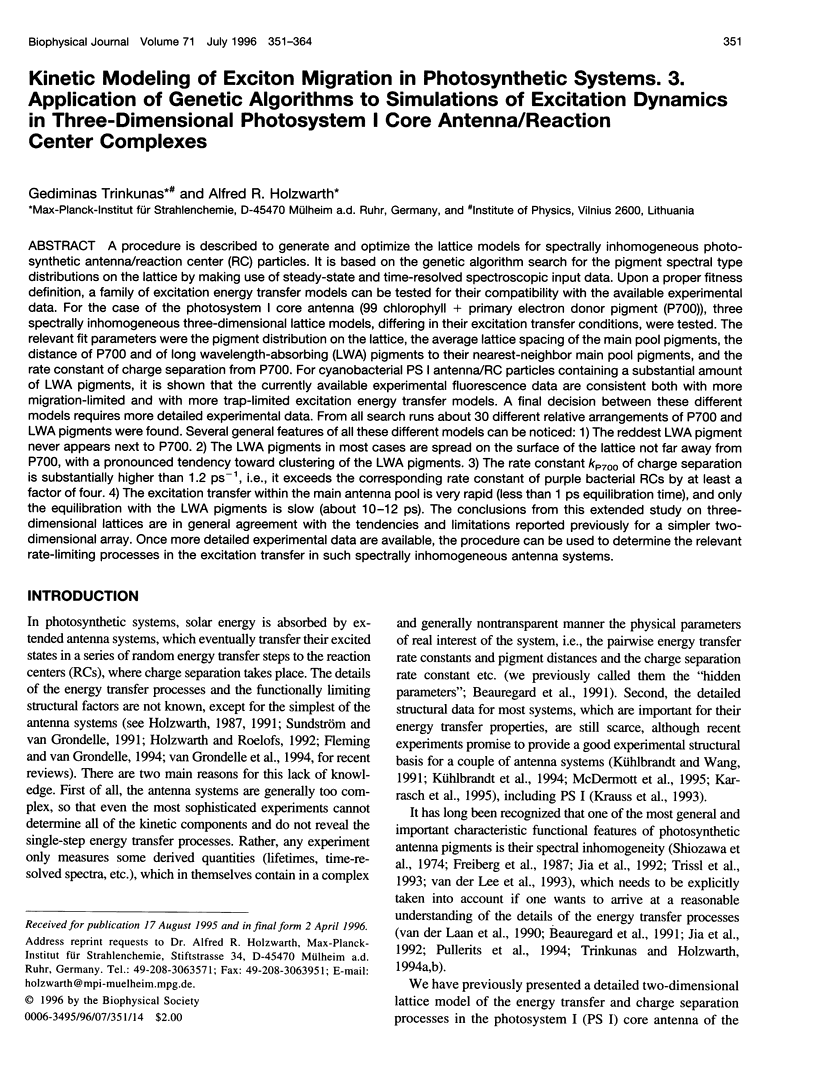
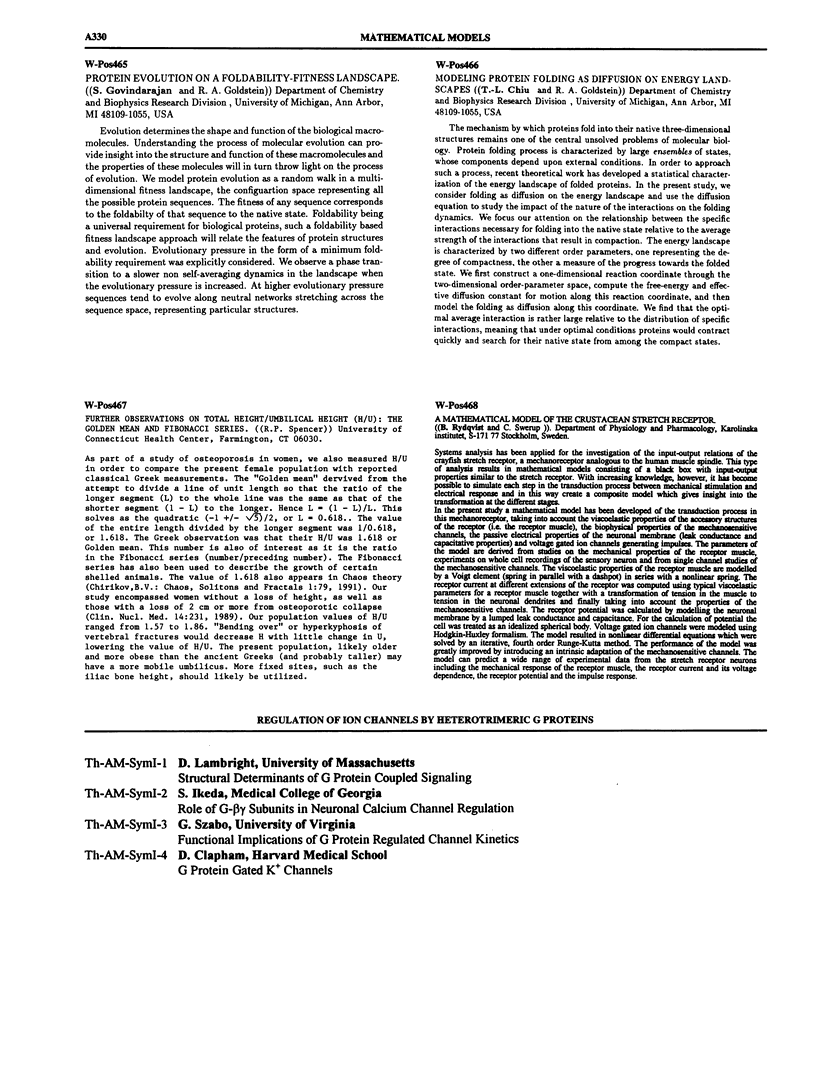
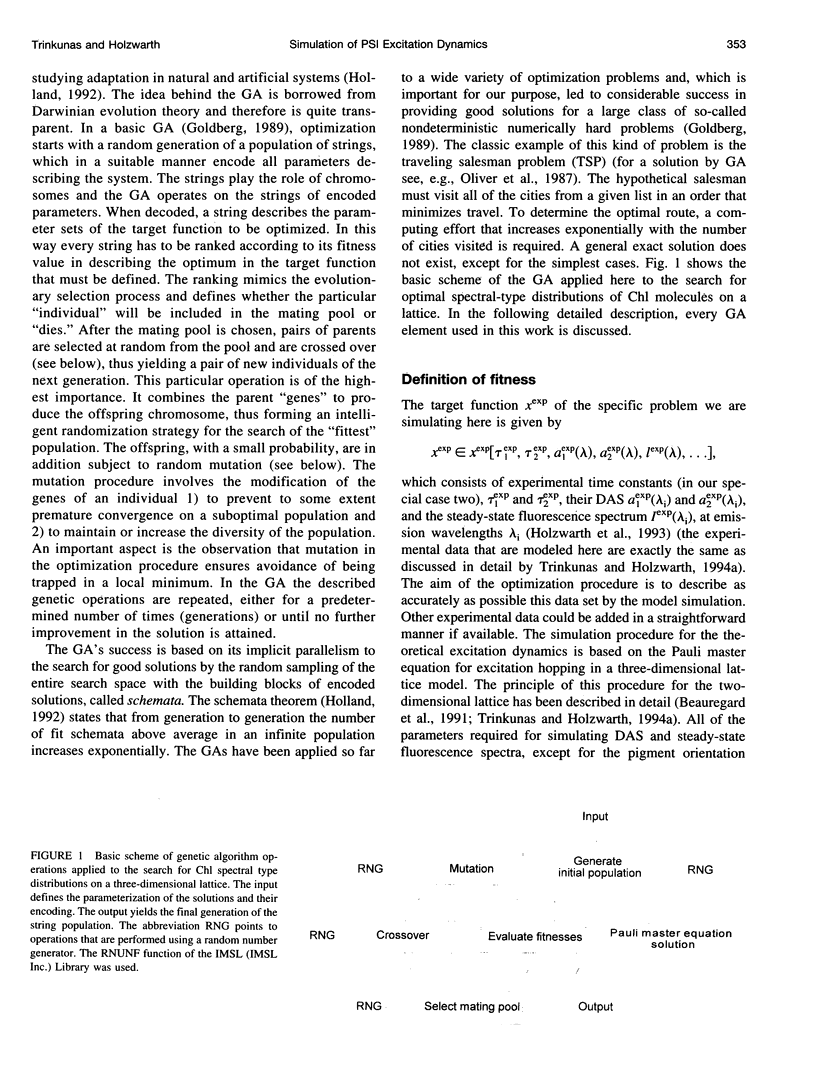
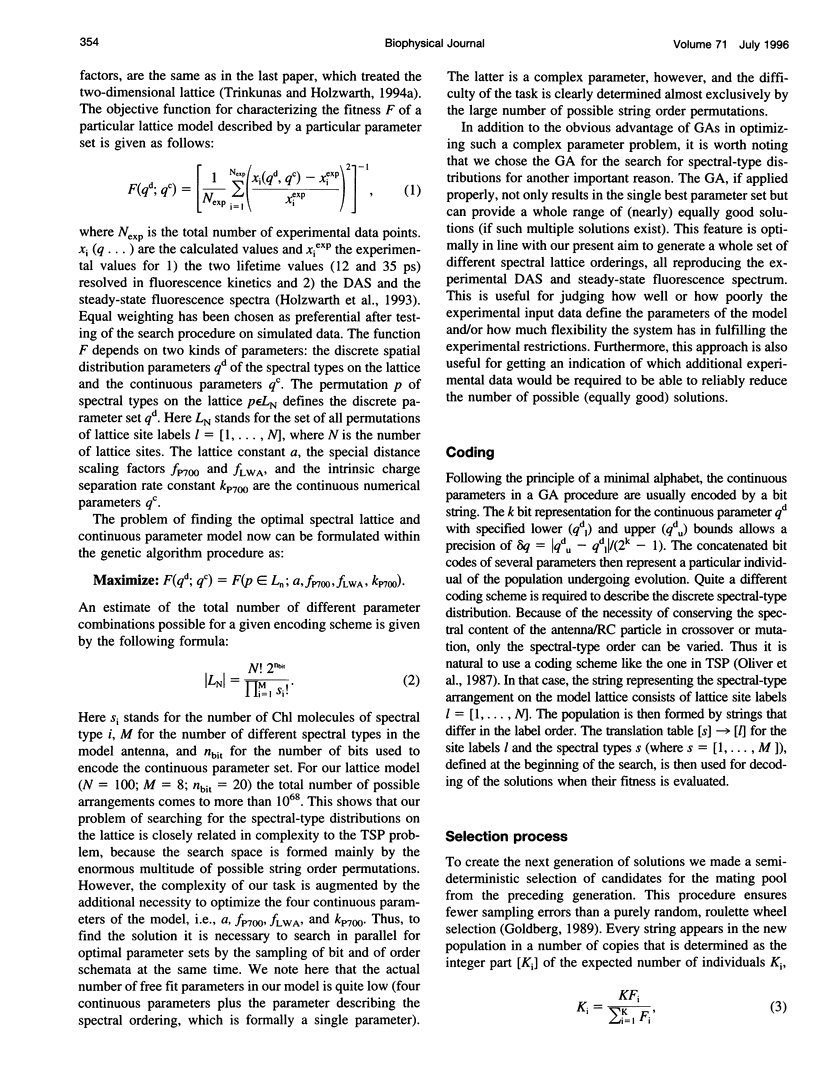
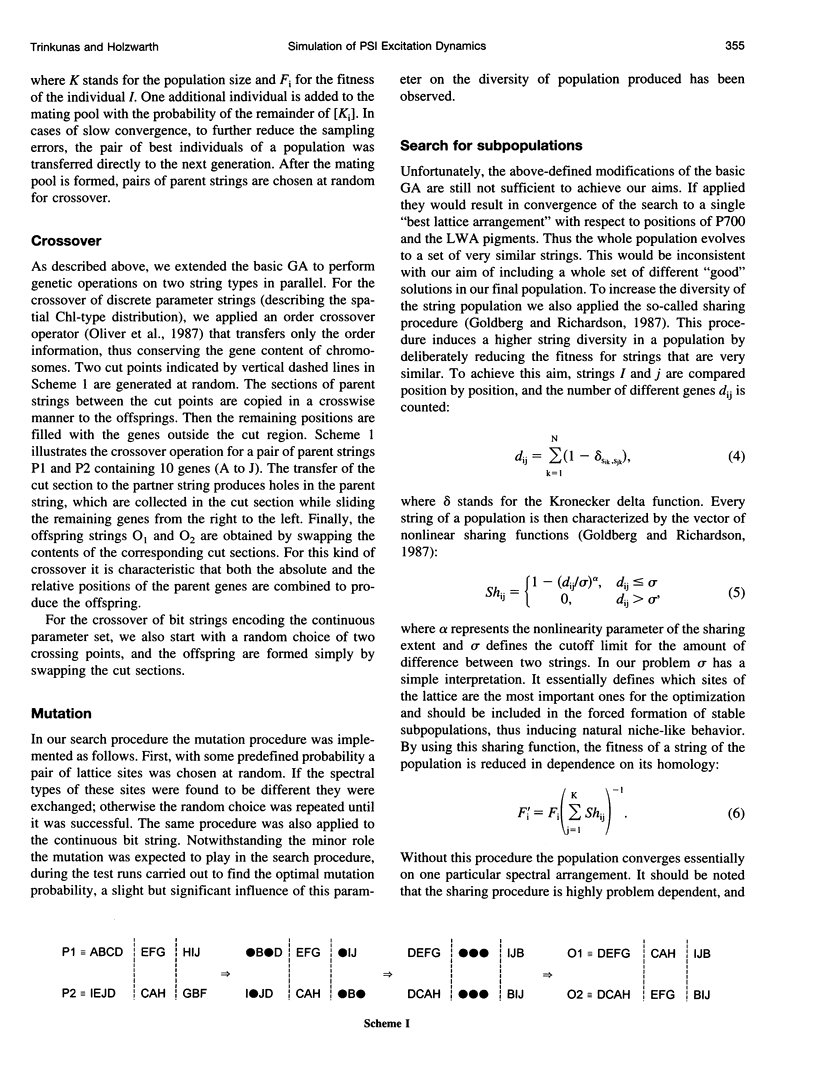
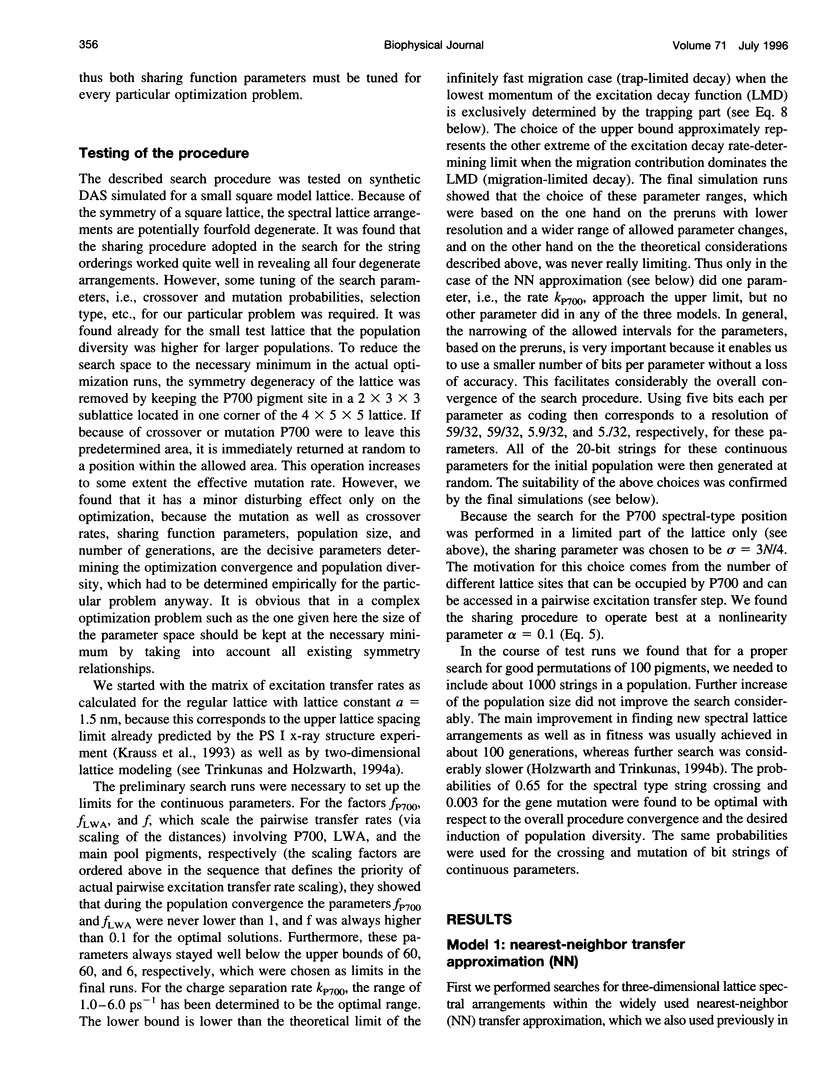
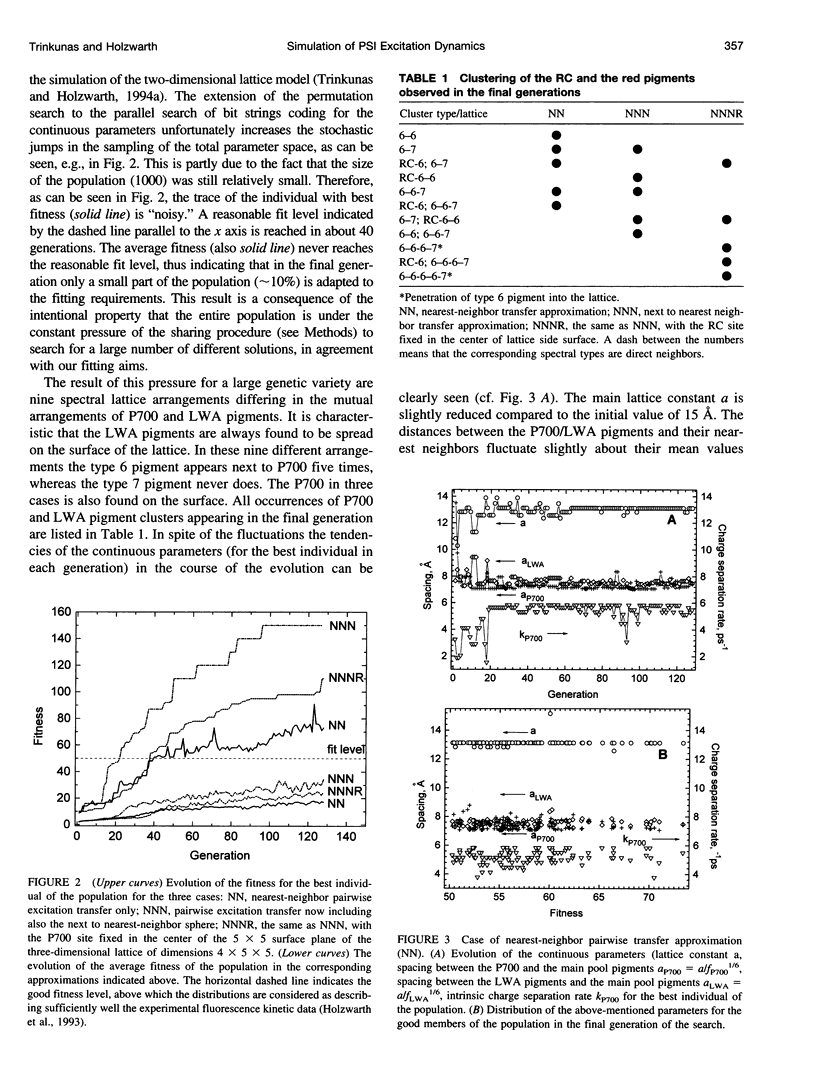
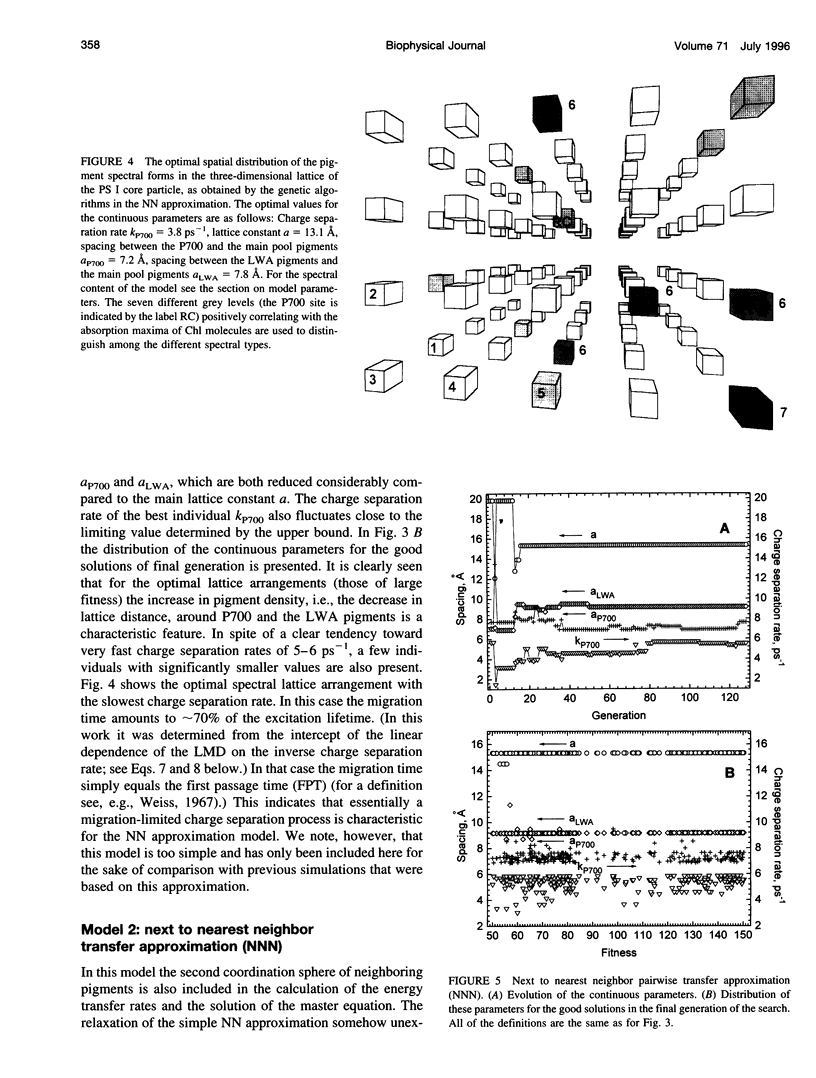
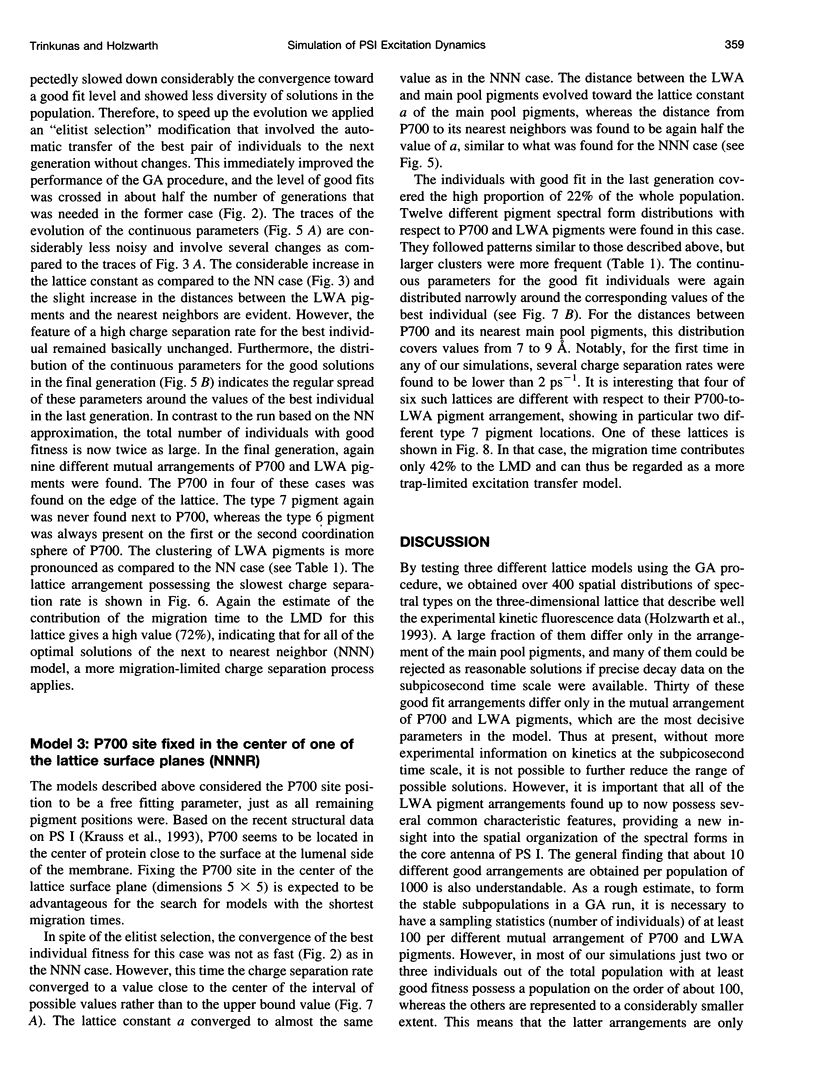
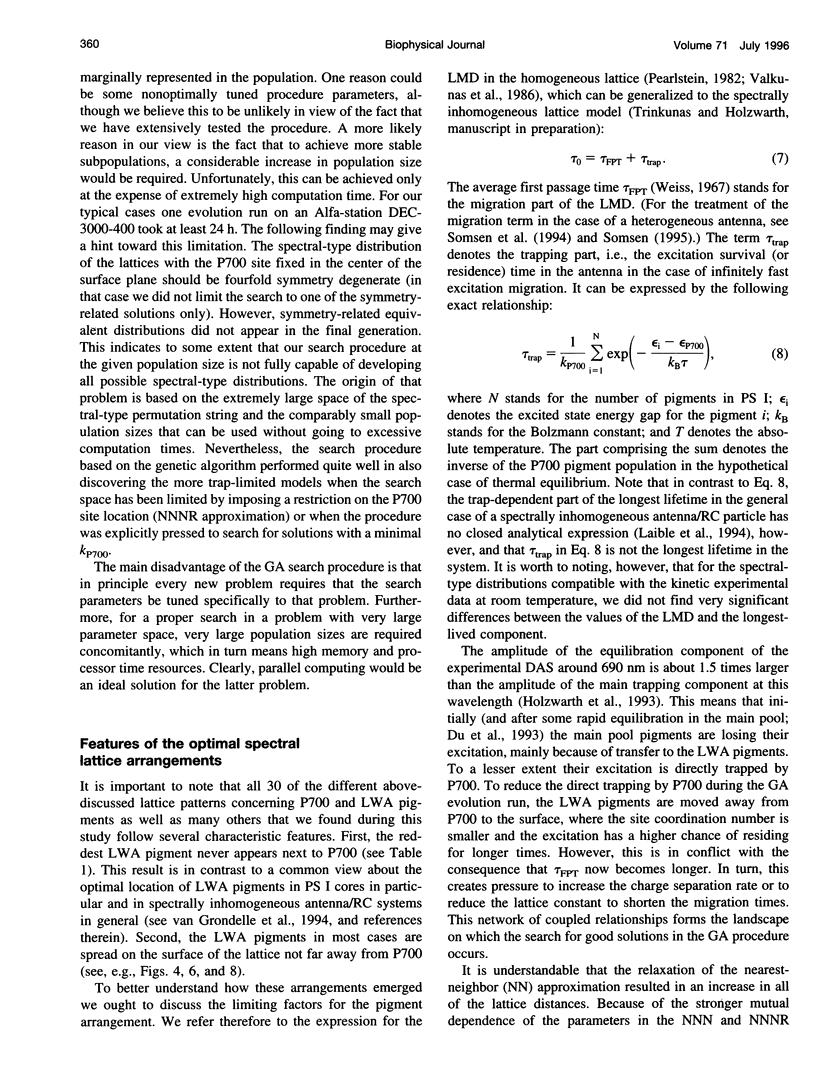
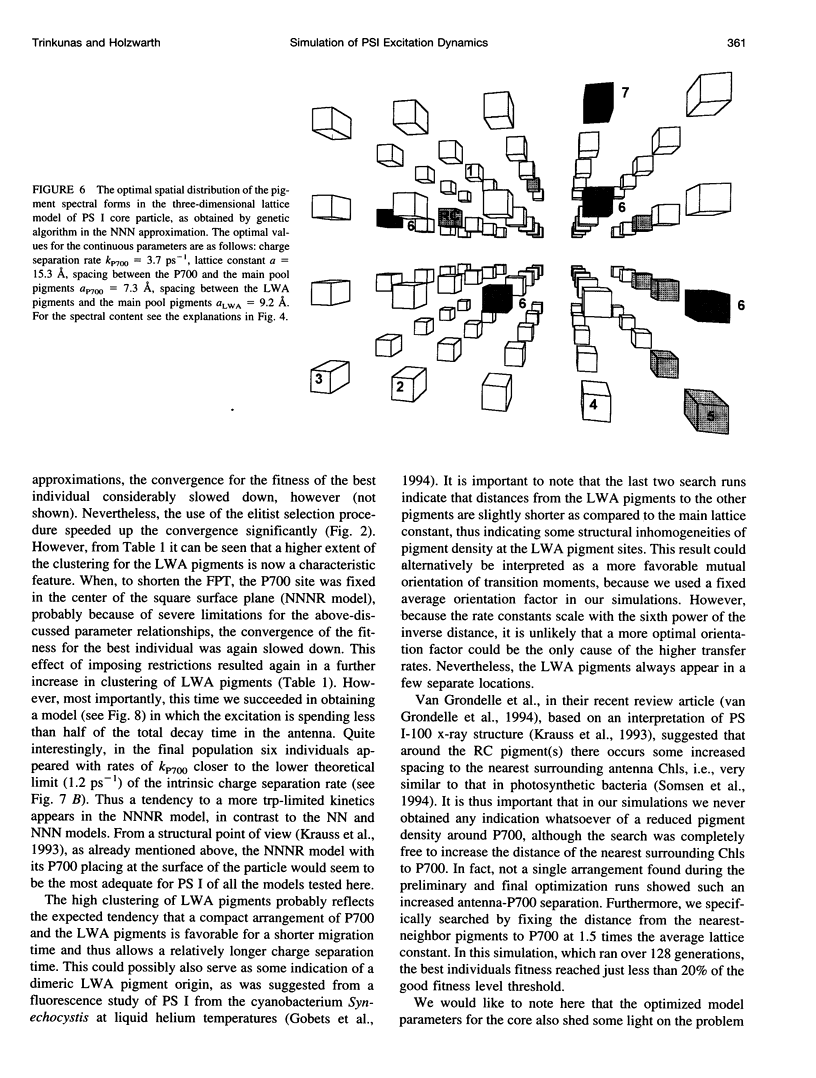
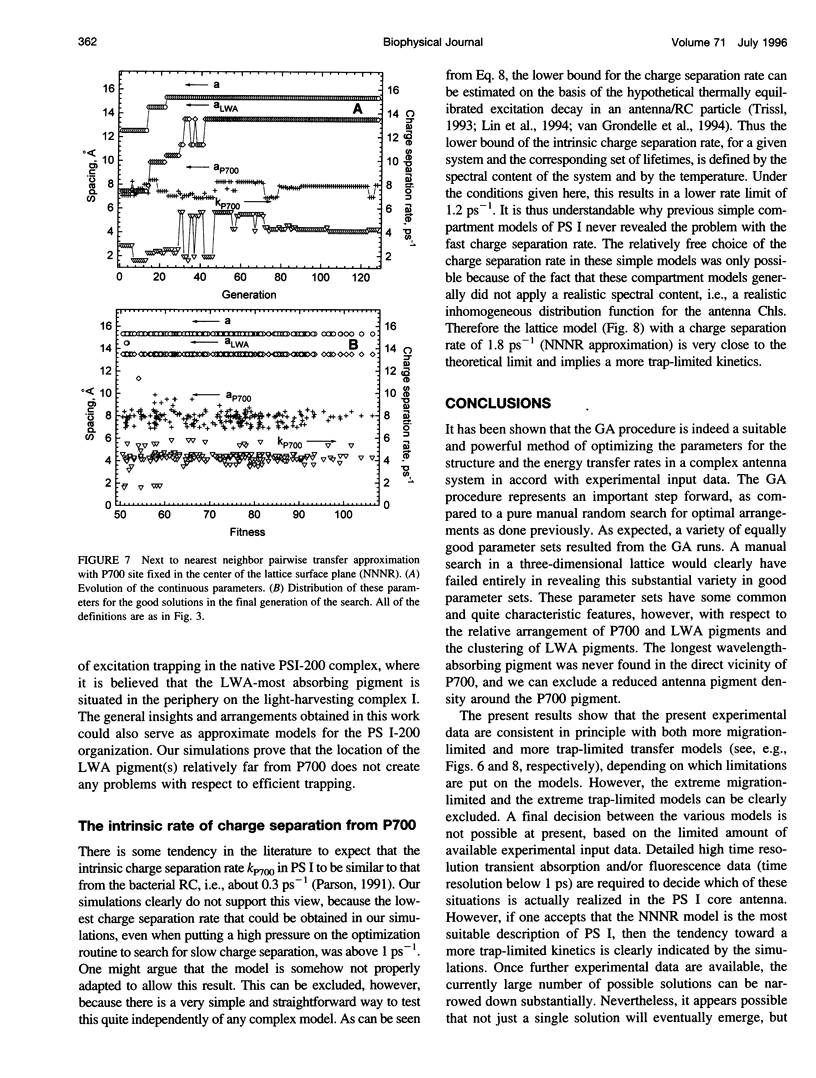

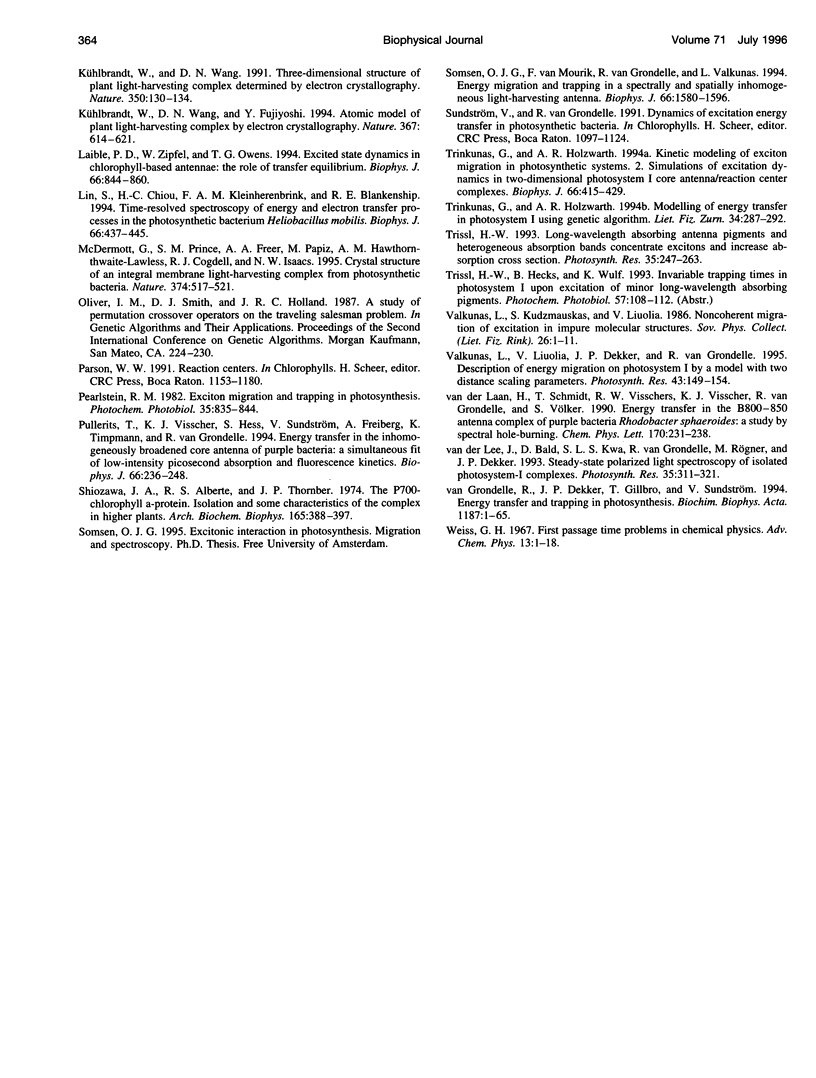
Images in this article
Selected References
These references are in PubMed. This may not be the complete list of references from this article.
- Holzwarth A. R., Schatz G., Brock H., Bittersmann E. Energy transfer and charge separation kinetics in photosystem I: Part 1: Picosecond transient absorption and fluorescence study of cyanobacterial photosystem I particles. Biophys J. 1993 Jun;64(6):1813–1826. doi: 10.1016/S0006-3495(93)81552-2. [DOI] [PMC free article] [PubMed] [Google Scholar]
- Jia Y., Jean J. M., Werst M. M., Chan C. K., Fleming G. R. Simulations of the temperature dependence of energy transfer in the PSI core antenna. Biophys J. 1992 Jul;63(1):259–273. doi: 10.1016/S0006-3495(92)81589-8. [DOI] [PMC free article] [PubMed] [Google Scholar]
- Karrasch S., Bullough P. A., Ghosh R. The 8.5 A projection map of the light-harvesting complex I from Rhodospirillum rubrum reveals a ring composed of 16 subunits. EMBO J. 1995 Feb 15;14(4):631–638. doi: 10.1002/j.1460-2075.1995.tb07041.x. [DOI] [PMC free article] [PubMed] [Google Scholar]
- Kühlbrandt W., Wang D. N., Fujiyoshi Y. Atomic model of plant light-harvesting complex by electron crystallography. Nature. 1994 Feb 17;367(6464):614–621. doi: 10.1038/367614a0. [DOI] [PubMed] [Google Scholar]
- Kühlbrandt W., Wang D. N. Three-dimensional structure of plant light-harvesting complex determined by electron crystallography. Nature. 1991 Mar 14;350(6314):130–134. doi: 10.1038/350130a0. [DOI] [PubMed] [Google Scholar]
- Laible P. D., Zipfel W., Owens T. G. Excited state dynamics in chlorophyll-based antennae: the role of transfer equilibrium. Biophys J. 1994 Mar;66(3 Pt 1):844–860. doi: 10.1016/s0006-3495(94)80861-6. [DOI] [PMC free article] [PubMed] [Google Scholar]
- Lin S., Chiou H. C., Kleinherenbrink F. A., Blankenship R. E. Time-resolved spectroscopy of energy and electron transfer processes in the photosynthetic bacterium Heliobacillus mobilis. Biophys J. 1994 Feb;66(2 Pt 1):437–445. doi: 10.1016/s0006-3495(94)80794-5. [DOI] [PMC free article] [PubMed] [Google Scholar]
- Pullerits T., Visscher K. J., Hess S., Sundström V., Freiberg A., Timpmann K., van Grondelle R. Energy transfer in the inhomogeneously broadened core antenna of purple bacteria: a simultaneous fit of low-intensity picosecond absorption and fluorescence kinetics. Biophys J. 1994 Jan;66(1):236–248. doi: 10.1016/S0006-3495(94)80770-2. [DOI] [PMC free article] [PubMed] [Google Scholar]
- Shiozawa J. A., Alberte R. S., Thornber J. P. The P700-chlorophyll a-protein. Isolation and some characteristics of the complex in higher plants. Arch Biochem Biophys. 1974 Nov;165(1):388–397. doi: 10.1016/0003-9861(74)90177-5. [DOI] [PubMed] [Google Scholar]
- Somsen O. J., van Mourik F., van Grondelle R., Valkunas L. Energy migration and trapping in a spectrally and spatially inhomogeneous light-harvesting antenna. Biophys J. 1994 May;66(5):1580–1596. doi: 10.1016/S0006-3495(94)80950-6. [DOI] [PMC free article] [PubMed] [Google Scholar]
- Trinkunas G., Holzwarth A. R. Kinetic modeling of exciton migration in photosynthetic systems. 2. Simulations of excitation dynamics in two-dimensional photosystem I core antenna/reaction center complexes. Biophys J. 1994 Feb;66(2 Pt 1):415–429. doi: 10.1016/s0006-3495(94)80792-1. [DOI] [PMC free article] [PubMed] [Google Scholar]






